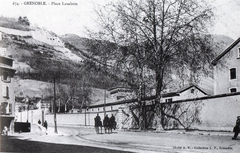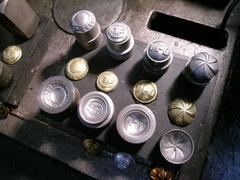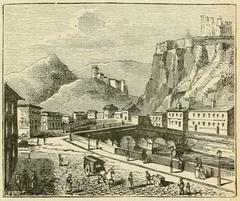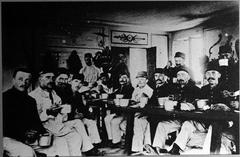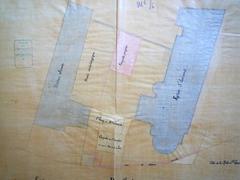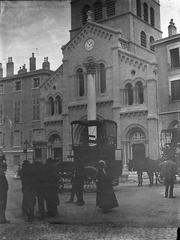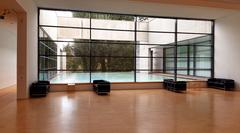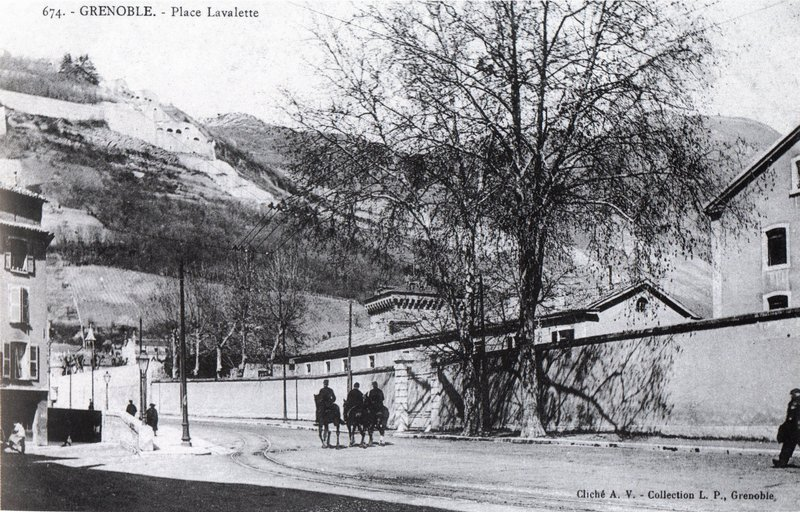
Complete Guide to Caserne Vinoy Visiting Hours, Tickets, and Grenoble Historical Sites
Date: 14/06/2025
Introduction to Caserne Vinoy and Its Historical Significance
Nestled at the heart of Grenoble, France, Caserne Vinoy is a remarkable testament to the city’s military and urban evolution. Originally established in the late 19th century atop layers of earlier history—from medieval fortifications to the Cordeliers’ convent—the barracks were named in honor of General Joseph Vinoy and played a pivotal defensive role at the gateway to the Alps. Caserne Vinoy’s strategic location made it integral to housing and training infantry regiments, especially during the turbulence of both World Wars. Though the original buildings were demolished in the 1980s, the site has since been transformed into the Esplanade of the Grenoble Museum, seamlessly blending historical remnants such as 16th-century citadel walls and the medieval Tour de l’Isle with modern public art installations by artists like Alexander Calder and Mark di Suvero.
This comprehensive guide provides all the essential information for visiting Caserne Vinoy and its environs. Here, you’ll find the site’s deep historical background, insights into its adaptive architecture, current visiting hours and ticketing, accessibility details, and travel tips for engaging with Grenoble’s vibrant museum district. Whether you’re a history enthusiast, architecture lover, or simply eager to explore Grenoble’s layered heritage, this guide will help you experience one of the city’s most significant landmarks. For official details on visiting hours and events, consult the Grenoble Tourism website. For enhanced exploration, consider the Audiala app, offering audio guides and interactive tours of Caserne Vinoy and other historical sites across France.
Further reading on Grenoble’s military and urban heritage is available through resources such as the Monumentum database, Chemins de Mémoire, and architectural analyses from the Kurby Blog.
Contents
- Introduction
- Historical Overview of Caserne Vinoy
- Origins and Early History
- 19th and Early 20th Century Role
- World War II and the French Resistance
- Postwar Transformation
- Architectural Evolution and Features
- Cultural Significance
- Visiting Caserne Vinoy Today
- What to See
- Visiting Hours and Tickets
- Accessibility
- Guided Tours and Events
- Visitor Experience: Photography, Etiquette, and Interactive Content
- Nearby Attractions
- Tips for Visitors
- FAQ
- Plan Your Visit
- Conclusion
Historical Overview of Caserne Vinoy
Origins and Early History
Caserne Vinoy was constructed on a site that had long served military and religious functions in Grenoble. During the Wars of Religion in the late 16th century, the Duke of Lesdiguières built a major citadel here—remnants of which, including two sections of the walls, are still visible along the Jongkind quay (Grenoble Museum Esplanade). The area’s defensive importance was further underscored by its proximity to the Isère River, serving as a bulwark for the city.
19th and Early 20th Century Role
Named for General Joseph Vinoy, the barracks became a base for infantry regiments and training, reflecting Grenoble’s growing military significance. Its design was shaped by the urgent need for robust, efficient facilities in the wake of the Franco-Prussian War (Kurby Blog).
World War II and the French Resistance
During World War II, Caserne Vinoy was occupied first by Italian, then German forces. It served as a focal point for local Resistance movements, including Combat and Franc-Tireur, who used the site for organizing sabotage and storing materiel. The destruction of the nearby Bonne barracks by the Resistance in December 1943 hastened Grenoble’s liberation on August 22, 1944 (Chemins de Mémoire).
Postwar Transformation
With changing military needs, Caserne Vinoy was decommissioned and demolished in the 1980s. The site was reborn as the Esplanade of the Grenoble Museum, now featuring modern sculptures, green spaces, and preserved sections of historic walls (Grenoble Museum Esplanade), alongside the Tour de l’Isle.
Architectural Evolution and Features
Caserne Vinoy epitomizes late 19th-century military architecture:
- Rationalist Design: Rectilinear blocks and symmetrical courtyards were standard, facilitating troop movement and assembly.
- Robust Materials: Thick stone and brick walls, locally sourced, provided both insulation and defense.
- Minimal Ornamentation: The facades emphasized durability and order over decorative flourishes.
- Adaptive Reuse: Following decommissioning, the site was transformed for civic and cultural use. The barracks’ structural integrity made conversion into offices and event spaces practical, demonstrating Grenoble’s commitment to sustainable urban development (Kurby Blog).
Cultural Significance
Military Heritage
Caserne Vinoy embodies Grenoble’s strategic significance through centuries of military activity. Its presence is a reminder of the city’s defensive role at the entrance to the Alps and is frequently referenced in local historical narratives and guided tours (PlanetWare).
Community and Education
Today, the site serves as a civic and cultural hub, hosting exhibitions, community events, and educational programs. Its transformation is celebrated as a model of heritage-led urban regeneration (Kurby Blog). The site is also used in architectural and urban planning studies.
Visiting Caserne Vinoy Today
What to See
- Esplanade of the Grenoble Museum: A public cultural space with contemporary art.
- Remnants of 16th-century citadel walls: Visible along Jongkind quay.
- Tour de l’Isle: A medieval tower dating to 1418.
- Modern Sculptures: Works by Alexander Calder and Mark di Suvero.
Visiting Hours and Tickets
- Esplanade: Open year-round, free access at any time.
- Musée de Grenoble: Tuesday–Sunday, 10:00 AM–6:00 PM (closed Mondays). Tickets required.
- Museum of Resistance and Deportation: Tuesday–Sunday, 10:00 AM–6:00 PM. Admission fees apply.
Always check the Grenoble Tourism website for up-to-date information.
Accessibility
The Esplanade and most surrounding sites are wheelchair accessible. Public transport (tram and bus) provides convenient access.
Guided Tours and Events
Guided tours, including those focusing on military history and architecture, can be booked through the tourism office. Special events and exhibitions are frequently held at the Esplanade and museums.
Visitor Experience: Photography, Etiquette, and Interactive Content
Photography is encouraged in public areas, especially for capturing the juxtaposition of historic and modern features. Please respect signage indicating restricted access and avoid touching preserved structures.
Interactive maps and virtual tours are available via the Grenoble Tourism website, enhancing your onsite experience.
Nearby Attractions
- La Bastille: Hilltop fortress with panoramic views and exhibitions (Best Things to Do in Grenoble).
- Pont de la Citadelle: Historic bridge with scenic river views.
- Maison natale de Stendhal: Museum dedicated to the famous writer.
- Jardin de Ville: French garden ideal for relaxation.
Tips for Visitors
- Visit in Spring or Autumn: Enjoy Grenoble’s pleasant climate.
- Plan Ahead: Check event and tour schedules, especially for special occasions.
- Combine Sites: Explore the museum district alongside Caserne Vinoy.
- Use Public Transport: Parking is limited in the city center.
Frequently Asked Questions (FAQ)
Q: Can I visit the original Caserne Vinoy?
A: The original barracks were demolished, but the site can be explored as the Esplanade and surrounding public space.
Q: What are the visiting hours?
A: The Esplanade is always open; museums have specific opening hours.
Q: Are guided tours available?
A: Yes, through the tourism office, especially during events.
Q: Is there an entrance fee?
A: The Esplanade is free; museum visits and some events require tickets.
Q: Is the site wheelchair accessible?
A: Yes, public spaces and museums are generally accessible.
Plan Your Visit
Maximize your experience by downloading the Audiala app for audio tours and updates. Check Grenoble Tourism for the latest information on events, exhibitions, and accessibility.
Conclusion
Caserne Vinoy is a vital part of Grenoble’s living heritage—bridging military history, architectural innovation, and dynamic civic life. Its adaptive reuse as a cultural space underscores the city’s commitment to honoring the past while engaging the present. Whether you’re interested in history, art, or simply enjoying a walk through one of Grenoble’s most historic districts, Caserne Vinoy is a must-visit destination.
Sources
- Esplanade of the Grenoble Museum – Grenoble Tourism
- Kurby Blog: The Evolution of Grenoble’s Architecture
- Monumentum: Caserne Vinoy in Grenoble
- Grenoble Tourism Official Website
- Chemins de Mémoire: Liberation of Grenoble
- PlanetWare: Tourist Attractions in Grenoble
- Best Things to Do in Grenoble
